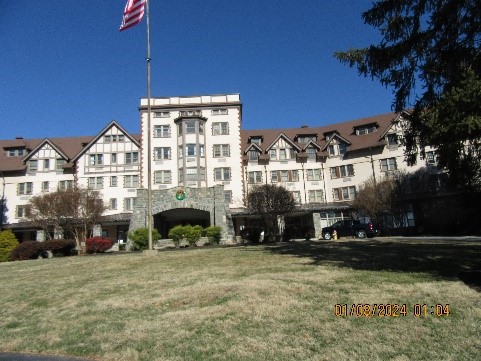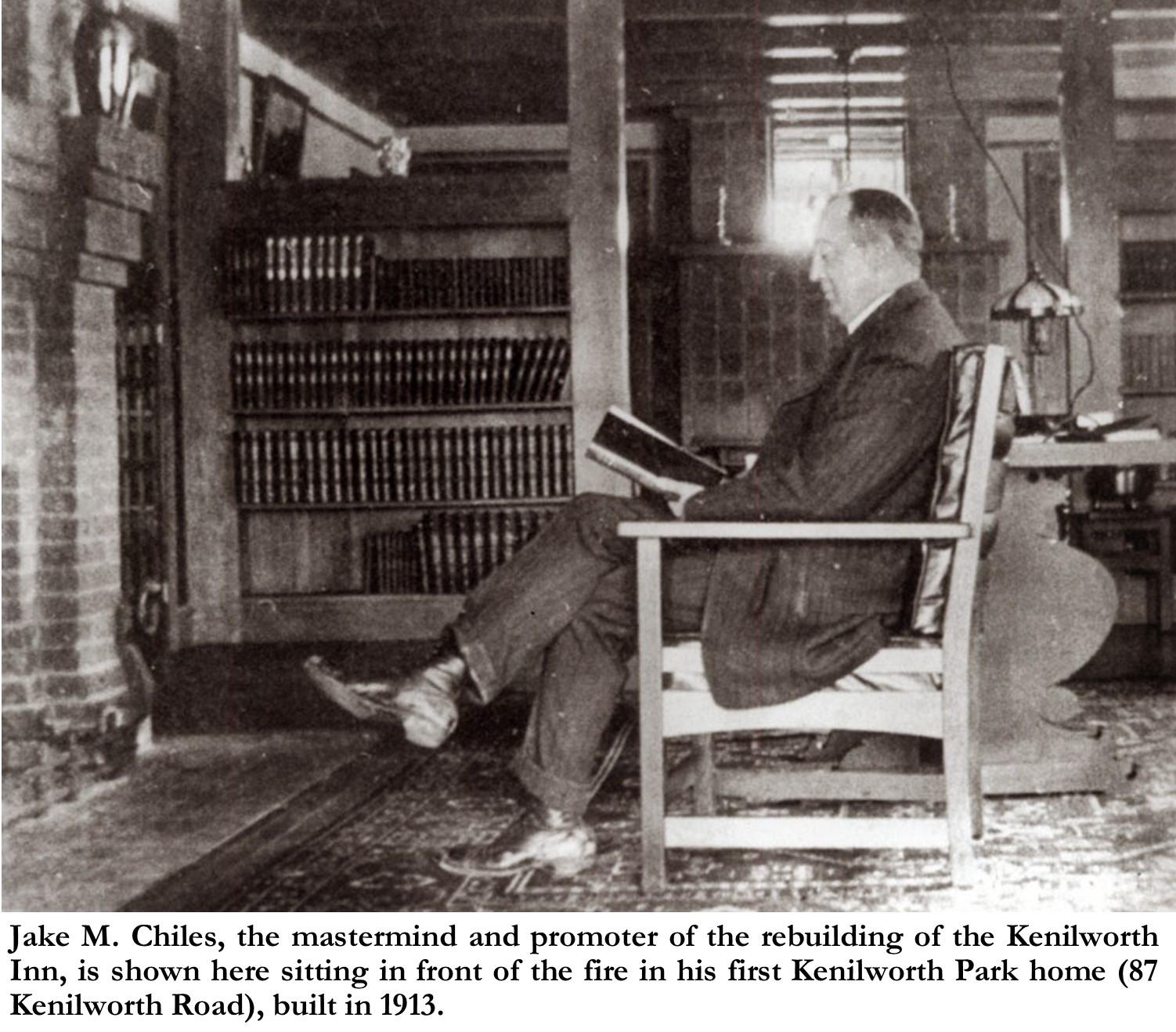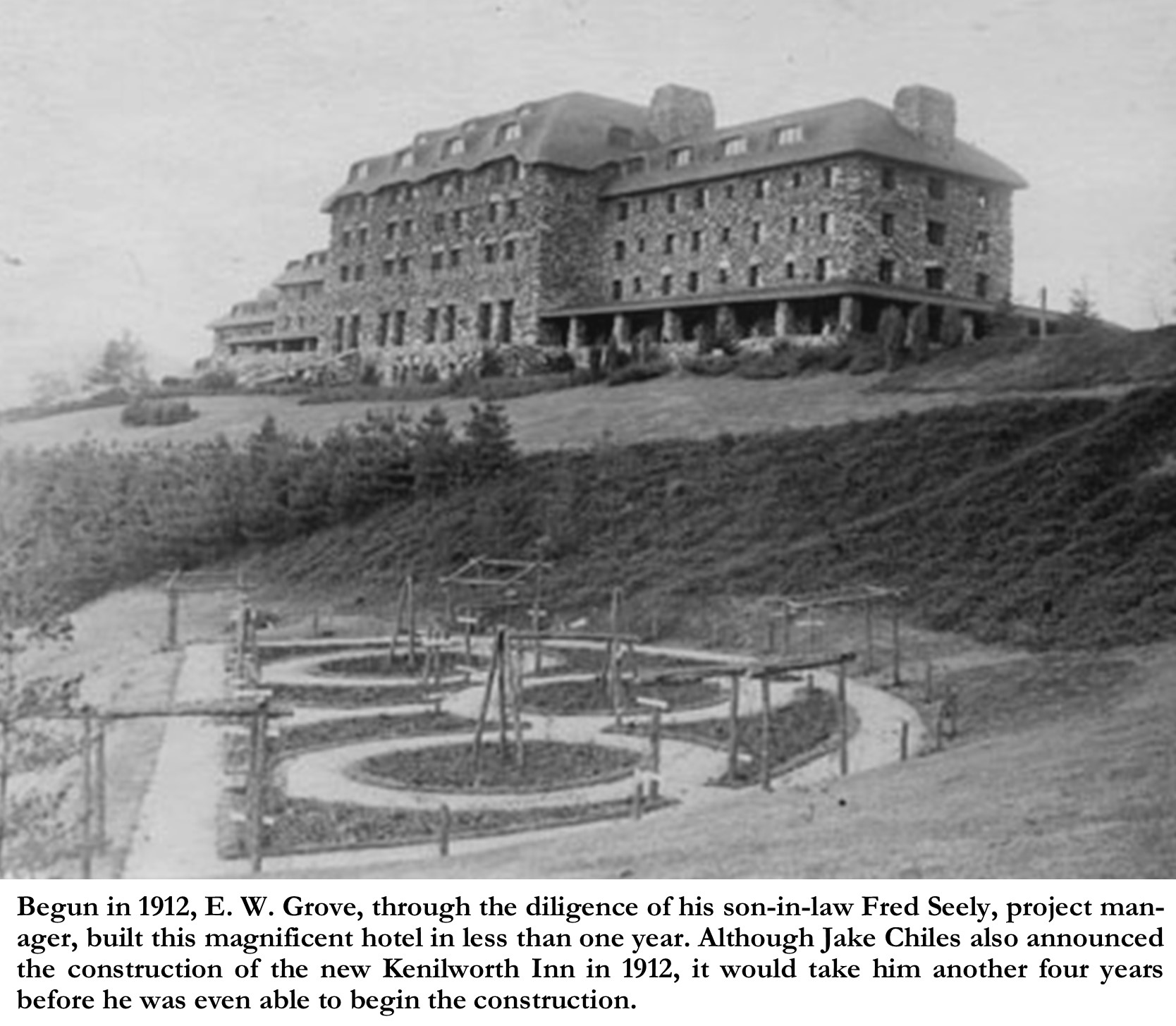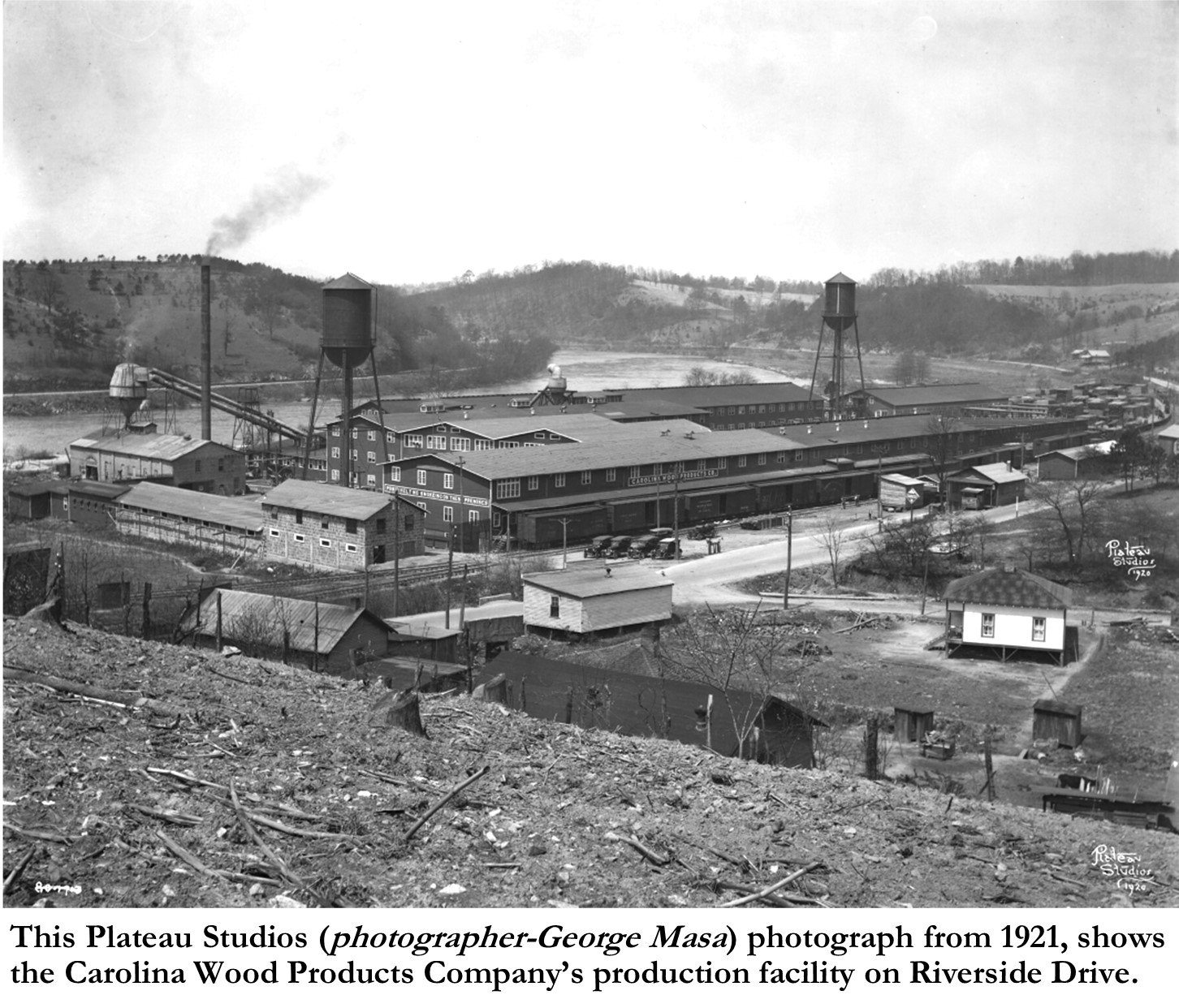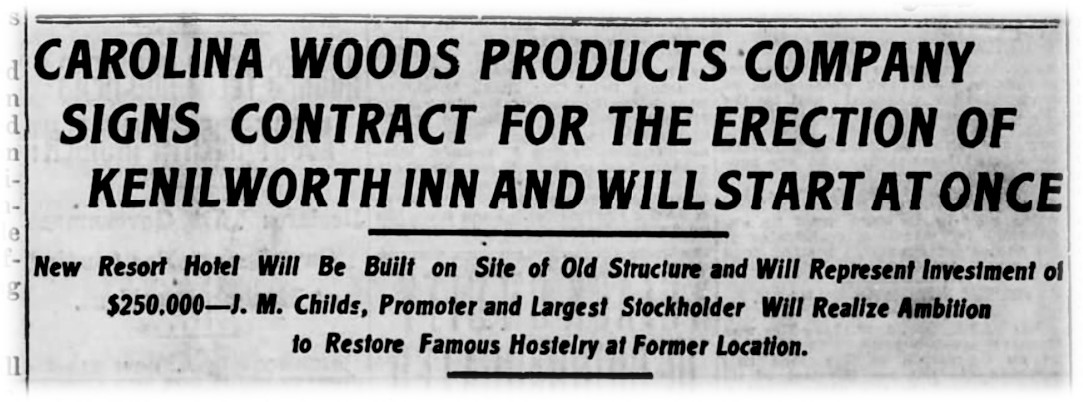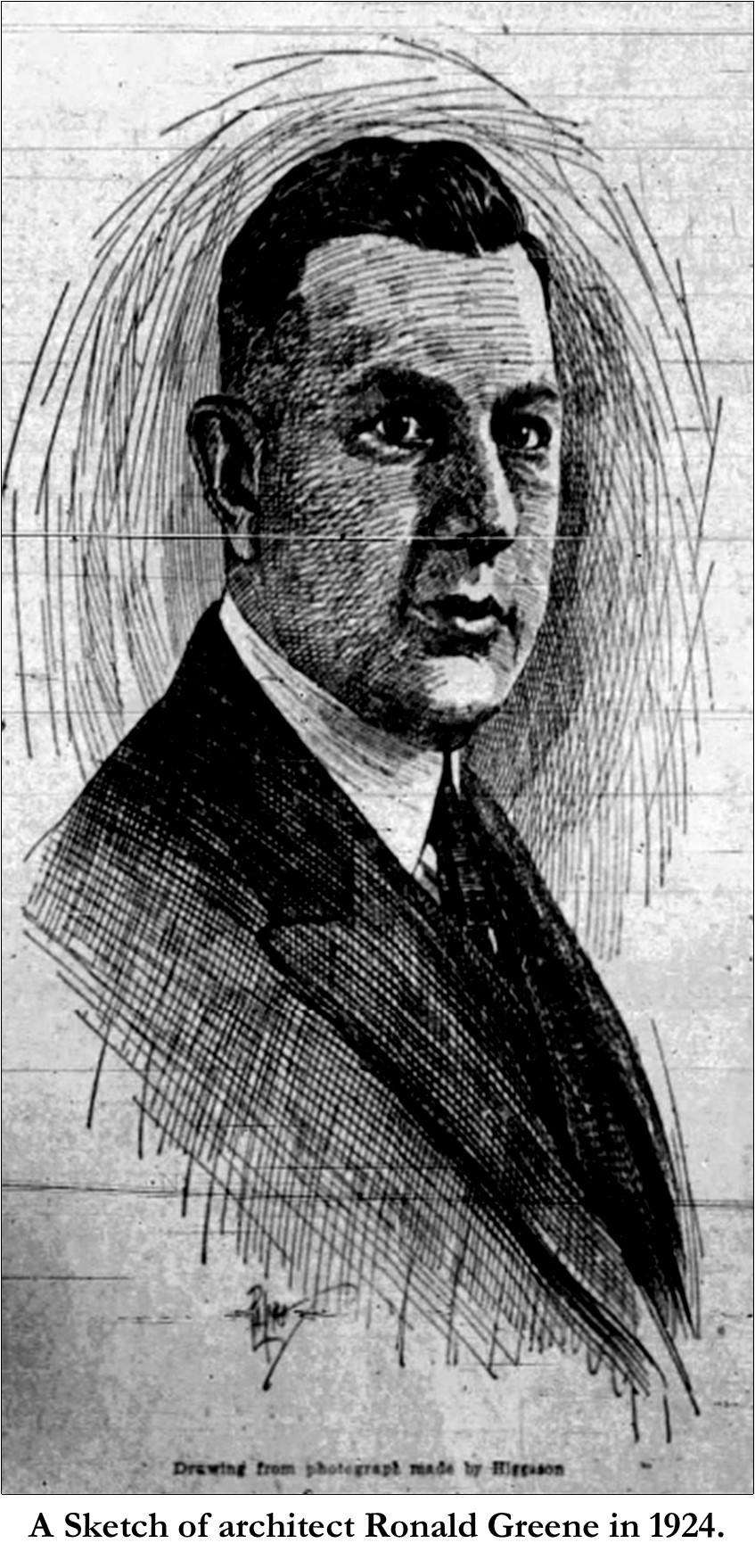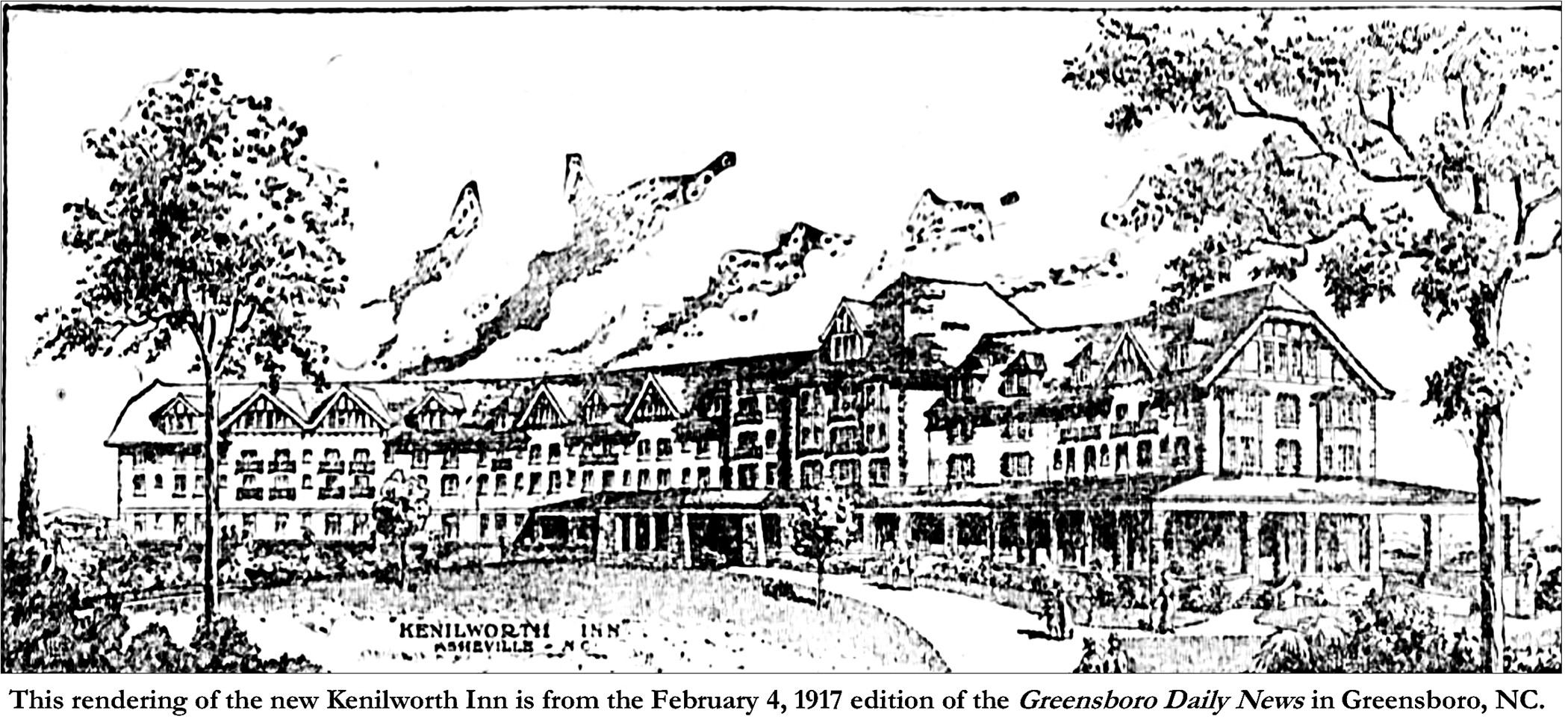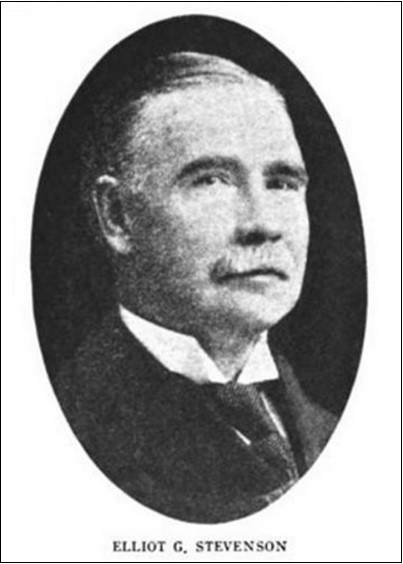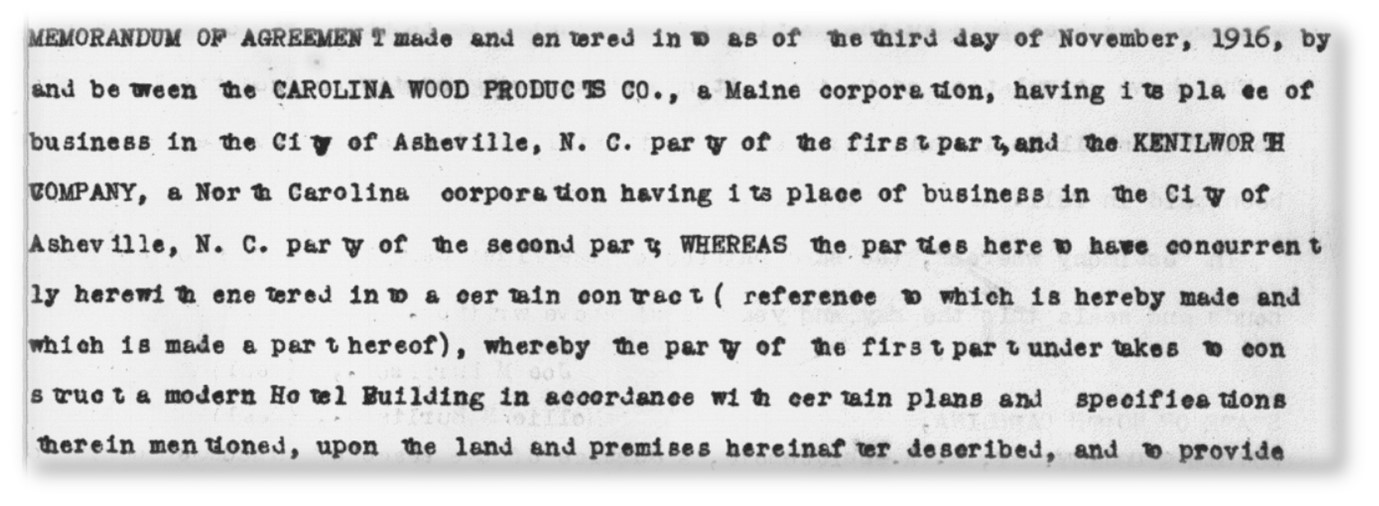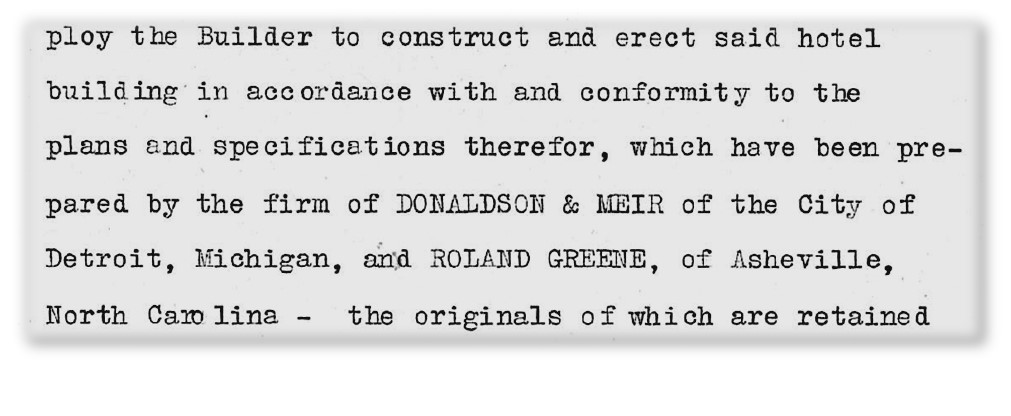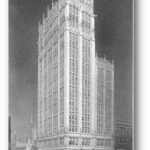By Dale Wayne Slusser- March 12, 2024
“Kenilworth Inn is thought to be designed by Ronald Greene, a prominent architect in Asheville who designed a number of the city’s downtown buildings on Pack Square.”[1] So concluded the preparer of the official National Register of Historic Places nomination for the 1917 Kenilworth Inn. Being an architectural historian who loves to take on such architectural mysteries, “Is thought”, quickly caught my eye! Although I had touched on this in a previous article on Greene, I decided to delve deeper into this mystery to try to solve it! Come with me on the journey to find the answer to the question: “Did Ronald Greene design the 1917 Kenilworth Inn?”.
The mystery begins! In 1909, just after a tragic fire destroyed the original Kenilworth Inn, a group of local businessmen, Junius Adams and his father John S. Adams, and R. M. Fitzpatrick formed the Kenilworth Company, to buy out the lands of the former Kenilworth Land Company, which had not only built the original Inn, but had been the first developers of Kenilworth Park. The under-financed Kenilworth Company of 1909 had failed to sell/develop even one lot during its three-year existence. In stepped Asheville “booster” Jake M. Chiles! The Kenilworth Company, which had been mostly financed by Junius Adams was bought out in January of 1912 by the Kenilworth Development Company, a recently chartered company formed by Jake Chiles. To form and finance ($25,000) the new Kenilworth Development Company, Jake Chiles gathered a group of a few local, but mostly mid-west investors, including: “B. C. McVey, Grand Rapids, Mich., president; Jake M. Chiles, Asheville, vice-president and treasurer, and J. J. McCloskey, secretary. Other stockholders of the new company are F. R. Herrick of Cleveland, O., Charles A. Phelps of Grand Rapids, Mich., and R. R. Reynolds, Asheville.” [2] The new company, announced as “the forerunner of the erection of the magnificent hotel, costing $250,000, which will rise phoenix-like on the ashes of the old Kenilworth Inn”[3], stated its main purpose was to: “erect many bungalows and summer cottages around the lake which the company proposes to lay out on the site of the old brickyard on the Kenilworth property.”[4]
To add to the confusing list of company names (Kenilworth Company -1896; Kenilworth Land Company-1909; and Kenilworth Development Company-1912) in October of 1912, another company, named the Kenilworth Inn Company, was separately chartered to build and operate a new hotel. The new company’s authorized capital was “$250,000, with $51,000 paid in by P. B. Bowman of Birmingham, and J. M. Chiles and J. J. McCloskey of Asheville.”[5] Along with the announcement of formation of the Kenilworth Inn Company, on October 26, 1912, the Asheville Citizen-Times further (and surprisingly) announced that construction on the new inn would begin “within the next sixty days”[6], and that the contract was to be given to the Caldwell Construction Company of Chicago to erect the new Kenilworth Inn.[7] Indeed, in December of 1912, in a large front-page article of the Asheville Citizen-Times, it was announced that“Contract Has Been Let For New Kenilworth Inn”.[8] It was further reported in the article that the contract was a “conditional one”, the condition being, “that the bonds of the company be passed upon favorably”.[9] The bond approval was reported to be set for January 1, 1913, and that upon their approval construction would begin, with completion of construction to be by July 1, 1913. We can assume that the bonds spoken of, were a type of surety bond, which is a three-party agreement between a surety (often an insurance company), a contractor, and an owner. The surety, promises to satisfy the contractor’s obligations if the contractor fails to perform in accordance with the construction contract.[10] It was further reported the following day, that the new inn was to contain about 200 guestrooms, and would cost between $200,000 and $250,000, and that the construction would be of “veneer brick”.[11]
Apparently, the bonds were not approved, as all went quiet until June of 1913, a month before the construction was to have been completed. It was then reported, in an article reporting on the ongoing work of the Kenilworth Park, that: “It is expected that work will begin at a very early date on the construction of the new Kenilworth inn, although the company is not yet ready to announce its plans concerning the inn”.[12] But just a few months later, in October of 1913, a huge front-page article announced that construction “will begin early in December”, as $250,000 of bonds, to cover the now estimated costs of $300,000 “have already been floated” and that “eastern capitalists have signified their intention of taking up the balance.”[13] Despite the bravado, the deal still sounded very tenuous, and so, not surprisingly, December passed with no news of starting construction on the new inn.
To add to Chiles’ chagrin, in 1912, E. W. Grove had also announced the building of a new hotel on his North Asheville property. However, because Grove had the personal money to finance his project, and had a son-in-law, Fred Seely, who was an efficiency expert who superintended the construction, Grove’s grand hotel, “Grove Park Inn” was finished in less than a year and was operating by the end of 1913.
Apparently, the locals were starting to become suspicious that the construction of the Kenilworth Inn would ever begin. In March of 1914, in a small column of the Asheville Citizen-Times, titled “Notes and Comments”, in a humorous, though satirical, response to an apparent customer inquiry, the editor replied: “No Anabel, we can not comply with your request. The Citizen never rebuilds the Kenilworth Inn more than twice a year.”[14] Alas, no further mention of start of construction of the inn was reported until August of 1915, when in an article about the ongoing work of the Kenilworth Park development, it was reported:
Asked yesterday if the project for the new Kenilworth inn had been abandoned, Jake M. Chiles, general manager of the Kenilworth Development company, said, “Had it not been for the outbreak of the European war we would have been at work on the hotel by this time. All of our bonds have been placed, and indications point to the beginning of work early next year, or sooner, if the money market becomes easier”.[15]
Providentially for Jakes Chiles, and his investors, events elsewhere in Asheville were developing, which would significantly contribute to realizing his dream of rebuilding the Kenilworth Inn. In February of 1915, the Asheville Times, quoting the Andrews Sun, reported that:
“The Graham County Lumber Co., Col. Frank Buell, president, has purchased about 30 acres of land, adjoining the property of the North Carolina Tanning Extract Co., and will erect thereon a large woodworking plant, which will use over ten million feet of lumber annually, mostly low grade chestnut oak and other hardwoods.”
“In this immense plant which will be equipped with up-to-date machinery, the lumber will be kiln dried, and then cut up into table tops and other furniture dimension stock, also made into house trim, and a specialty will be made of “cares,” that is the small pieces will be glued together and made ready to be veneered onto later by furniture manufacturers.”[16]
The Graham County Lumber Company had been formed just a few years earlier by Col. Frank Buell and other associates from Bay City, Michigan.
An even more impactful event to the eventual building of new Kenilworth Inn happened on October 22, 1915, when the Asheville Citizen-Times, in a front-page article, broke the news of what it sensationally dubbed, “one of the largest developments in the history of Western North Carolina and one of the greatest industrial development projects in the life of Asheville”[17]. It was reported that the Graham County Lumber Company, in addition to and in conjunction with their vast timber tract holdings and other operations in Western North Carolina, had purchased out of receivership, the former American Furniture Manufacturing Company plant along the French Broad River in Woodfin, northeast of Asheville. Much to-do was made of the fact that this intentional deal was brokered by F. M. Weaver, who not only was the Receiver for the American Furniture Manufacturing Company, but also represented the Asheville Board of Trade, as chairman of its “industrial development committee”.[18]
Although it was sensationalized a bit, this was a massive undertaking. The plan was that the company would send the dressed lumber from its other operations scattered across Western North Carolina, to the new plant in Asheville “for development into furniture, houses, interior trim, and other products of a modern furniture factory and lumber yard”.[19] It was further announced that although the new plant was to remain owned and operated by the Graham County Lumber Company, that “a new name will be chosen for the Asheville factory”.[20] Three months later, on January 24, 1916, the Asheville Citizen Times made the following announcement:
Starting this morning, the furniture factory and plant for the manufacture of ready-cut houses on the French Broad River will doing business under the new name of the Carolina Wood Products Company. The corporation was chartered under the laws of the state of Maine on January 10.[21]
The new plant of the Carolina Wood Products Company, began operation in January of 1916 with a huge agenda of production. The plant would produce furniture, dimensional lumber, millwork, and sash work and “ready-cut houses”! And to add to the complexity of the company’s make-up, the Carolina Wood Products Company, also functioned as contractors, taking on sizeable construction projects, often acting as a design/build firm, furnishing architectural design and construction services.
In a September of 1916 front-page article of the Asheville Citizen-Times, titled “CAROLINA WOODS PRODUCTS COMPANY SIGNS CONTRACT FOR THE ERECTION OF KENILWORTH INN AND WILL START AT ONCE”, it was reported that “The plans and specifications for the new hotel have been completed by Charles Parker, who spent several weeks preparing them”.[22] Charles N. Parker was a young architect who had first come to Asheville (from Ohio) in the early 1900s, and after working for architect Richard Sharp Smith for several years, had recently opened his own architectural practice. Parker had perfected the English Tudor revival style, which he had been trained in working under the British-born Smith. And so Parker was a likely candidate to design the new Kenilworth Inn.
However, by November of 1916, not only was there no further mention of Charles Parker in relationship to the building of the Kenilworth Inn, but the Carolina Woods Products Company was now being reported to have “designed and planned” the new Kenilworth Inn, as evidenced in an interview with E. A. Fonda, “House Manager” for the Carolina Wood Products Company:
The question was asked Mr. Fonda if he could give the public some idea of the plans of the Kenilworth Inn which the Carolina Wood Products company was to build for the Kenilworth Hotel company, to which he said: “The hotel, which is strictly English architecture, has been designed and planned throughout in the architectural department of the Carolina Wood Products company, with the assistance of Mr. Donaldson, of the architectural firm of Donaldson and Meir, of Detroit, Mich., acting in the capacity of consulting architect. [23]
Clearly, it appeared that the Carolina Wood Products Company was acting as a design/build firm, acting both as architect and builder. Who was Donaldson & Meir of Detroit, Michigan, and why did the Carolina Wood Products Company need “Mr. Donaldson” as consulting architect? These were the questions that arose in my mind when I read that November 1916 newspaper report.
Donaldson and Meir (pronounced like and often spelled, Meier) was an architectural firm based in Detroit. Founded in 1880 by John Donaldson (1854–1941) and Henry J. Meier (died 1917), the firm produced a large and varied number of commissions in Detroit and southeastern Michigan. Donaldson, the principal designer of the partnership, was born in Stirling, Scotland and immigrated to Detroit at an early age. Donaldson had studied at the Art Academy in Munich, Germany, and at the École des Beaux-Arts in Paris, France.[24] But, why did the Carolina Wood Products Company need “Mr. Donaldson” as consulting architect? My guess on that is that Ronald Greene, who was the company’s “Chief architect” of their “architectural department”, was not yet licensed to practice architecture, and so needed Donaldson to sign-off and “seal” the drawings.
I also noticed that Donaldson & Meir were from Michigan, the home state of the majority stockholders of the Graham County Lumber Company and Carolina Wood Products Company! And of course, also the home state of Ronald Greene!-Ah, there is a Michigan connection?
In 1917, during the building of the Kenilworth Inn several newspapers published an architect’s rendering of the new Kenilworth Inn. The clearest one I have found is from the February 4, 1917 edition of the Greensboro Daily News in Greensboro, NC.[25] The rendering is labeled “Kenilworth Inn, Asheville NC”, but there is no mention of any architect or the builder. However, other renderings published during that time in the Asheville Citizen-Times, show the name of an architect under the title. Those renderings are so small and poorly printed that the name is unreadable. However, the printed title under the renderings clearly read: “CAROLINA WOD PRODUCTS COMPANY, ASHEVILLE N. C., Designers and Builders”, followed underneath by “Donaldson & Meier, Detroit, Mich., Associate Architects”.[26]
Ronald Greene was already working for the Carolina Wood Products Company by the time the Kenilworth Inn contract was signed, working as manager of its architectural department, as evidenced from an April 1916, series of Carolina Wood Products Company advertisements, such as this one from the New York Times:
DRAUGHTSMAN WANTED- Capable of developing house plans from sketches and making good tracing; advise whether three months’ employment would be considered. R. Greene, Carolina Wood Products Co., Asheville, N. C.
The above-mentioned advertisement not only confirms that Ronald Greene was working for the Carolina Wood Products Company at the time, but it also gives us a glimpse into the young 25-year old’s role as “Chief Architect” for the company. Greene was acting as an architect, drawing sketches (preliminary design/concept sketches) for “house plans”, and then handing the sketches off to “draughtsmen” to develop into detailed “working drawings” used for construction. This advertisement mentions “house plans”, indicating that Greene was the chief architect for the company’s “ready-cut” houses, but it does not mention the Kenilworth Inn.
In my previous article about the building of the Kenilworth Inn[27], I was uncertain if Ronald Greene had first come to Asheville looking for work, or if he had come to accept the position as an architect/engineer with the recently formed Carolina Wood Products Company? However, a recent discovery of a 1924 newspaper article has since answered my question. According to his own recollection, Greene first arrived in Asheville on January 1, 1916, as he had been “engaged [hired] by E. H. Stevenson, prominent attorney and financier of Detroit, to take charge of architectural work in this section, including designing and superintending a large number of buildings for Carolina Wood Products company, Carolina apartments, residences in Grove Park, and siginal [original] designs for Kenilworth Inn, which was later altered to suit conditions of government hospital”.[28]
“E. H. Stevenson” was Elliott G. Stevenson, a prominent lawyer in Detroit, Michigan, who had “represented all five major Detroit newspapers in libel charges during the late 1800s, and later defended the Chicago Tribune against a libel suit filed by Henry Ford.”[29] But more germane to our story, E. G. Stevenson was (in 1916) the President of the Carolina Wood Products Company, and his son G. E. (George Eliott) was the secretary-treasurer of the company. Although E. G. Stevenson visited Asheville on occasion, and although he is listed in the 1917 and 1918 city directories (residence given as: Detroit, Mich.), he never resided in Asheville. However, his son George Stevenson moved to Asheville and took an active role working in the Asheville offices of the Carolina Wood Products Company.[30] Although I’m not sure how Greene and Stevenson connected, most likely it was through their mutual Michigan connections.
In 1922, six years after the Kenilworth Inn was completed, Ronald Greene (then out on his own with his own firm) was hired to draw up remodeling plans for the Kenilworth Inn, which was then being used as a government military hospital. It was then reported that: “Ronald Greene, Architect, who drew the original plans for the erection of the Kenilworth Inn, is busy at work on plans for remodeling the property … [SIC]”[31]. Before it was even finished, in 1917 the U. S. War Department had commandeered the Kenilworth Inn to be used as a military hospital.
And so, although I had determined that Ronald Greene had been in the right place at the right time to have been the architect of the new Kenilworth Inn, and despite also having the 1922 newspaper article, stating that Greene “drew the original plans” for the Inn, I still needed more confirming evidence. Korey Maney, in is his 2001 nomination to get the Kenilworth Inn onto the National Register of Historic Places mentioned the following: “A memorandum of agreement entered by and between Carolina Wood Products Company and Kenilworth Company on November 3, 1916, credited the “firm of Donaldson & Meir of Detroit, Michigan and Roland [sp] Greene of Asheville, North Carolina” with the design of Kenilworth Inn”.[32] I suspected that this “memorandum of agreement” would provide the conclusive evidence that Ronald Greene was the architect of the 1916 Kenilworth Inn. However, finding this memorandum proved elusive.
I first searched on the Buncombe County Register of Deeds, looking for the aforesaid memorandum. Although I did find a memorandum of agreement, between the Kenilworth Company and the Carolina Wood Products Company, dated November 3, 1916[33], it proved to be a deed of trust, and more importantly had no references to Donaldson & Meir nor Ronald Greene. However, it did reference another contract that sounded like it could be the missing memorandum of agreement. In the first paragraph of the registered deed of trust was the following sentence: “WHEREAS, the parties here to have concurrently herewith entered into a certain contract (reference to which is hereby made and which is made a part thereof), whereby the party of the first part under takes to construct a modern Hotel Building in accordance with certain plans and specifications therein mentioned…”. As there was no other mention of those “certain plans and specifications” in the deed of trust, the “therein mentioned” clearly was referencing an additional document. So, I went back to Maney’s citation, and noticed that the memorandum of agreement he quoted, came from the “John Chiles” collection. John Chiles was the son of Jake M. Chiles, the developer of Kenilworth. John Chiles had donated his family “collection” of photos and materials from the building of the Kenilworth Inn and Kenilworth Park to the Buncombe County Special Collections to be scanned to have copies in their collection. However, despite a visit to Buncombe County Special Collections, and a thorough search through the materials of the “John Chiles Collection”, no such memorandum appeared.
Finally, in utter despair (not quite, but almost), the thought came to me that since Korey Maney had cited the memorandum, that he may have put a copy of it in the folder of materials that he had gathered to prepare the National Register nomination. So, I contacted the Western North Carolina office of the State Historic Preservation Office inquiring if perchance, a copy of the memorandum was in Maney’s nomination files. Sure enough, a copy of the 11-page memorandum of agreement was indeed in the files!
In this unsigned copy of the agreement, the Carolina Wood Products Company agreed to “construct and erect” the Kenilworth Inn “in accordance with and conformity to the plans and specifications therefor, which have been prepared by the firm of DONALDSON & MEIR, of the City of Detroit, Michigan and ROLAND [sp] GREENE of Asheville, North Carolina-the originals of which are retained by the builder.”[34] Since both architects had been named in this agreement as preparers of the “plans”, and since it was clearly indicated elsewhere that Donaldson & Meir were the “consulting architects”, it concludes therefore that Ronald Greene was the lead architect for the project. Both the building and the design of the new Kenilworth Inn, as well as the project financing (which is unusual), were provided by the Carolina Wood Products Company, with Ronald Greene and its architectural department at the lead.
Although architect Ronald Greene left Asheville in 1918, when the Carolina Wood Products Company decided to curtail their construction and design services and concentrate only on the manufacture of furniture, Greene would return three years later, in 1921, to establish his own architectural firm. For the ensuing four decades Ronald Greene, the architect of the Kenilworth Inn, would remain in Asheville and design many other exceptional buildings, contributing greatly to Asheville’s legendary historical architecture.
Photo & Image Credits: All captions and cropping by the author.
Photo of Kenilworth Inn- photo by author.
Jake M. Chiles at Home- Image #N822-8- Portrait of J. M. Chiles seated in a chair reading in his living room.- – Buncombe County Special Collections, Pack Library, Asheville, NC.
Vintage Grove park Inn Photo- Image # F252-5-View of Grove Park Inn from the SW, over an empty formal garden.- – Buncombe County Special Collections, Pack Library, Asheville, NC.
Carolina Wood Products Company Mill, Asheville, NC- University of North Carolina Asheville, E. W. Ball Photographic Collection, Ball1775– accessed from: https://southernappalachiandigitalcollections.org/object/3820
Carolina Woods Products Company Signs Contract headline- “CAROLINA WOODS PRODUCTS COMPANY SIGNS CONTRACT FOR ERECTION OF THE KENILWORTH INN AND WILL START AT ONCE”, Asheville Citizen-Times, September 22, 1916, page 1. -newspapers.com
Sketch portrait of Ronald Greene- “Asheville Men of Affairs”, Asheville Times, October 7, 1924, page 1. -newspapers.com
Rendering of the new Kenilworth Inn- “NEW KENILWORTH INN UNDER CONSTRUCTION AT ASHEVILLE”, Greensboro Daily News, Greensboro, NC, February 4, 1917, page 27. -newspapers.com
Advertisement for “Draughtsmen”- from The New York Times, April 11, 1916, page 23. -newspapers.com
Portrait of Elliot G. Stevenson- Bench & Bar of Michigan: Nineteen Hundred Eighteen – Bench and Bar Publishing Company, 1918, Page 145. –googlebooks.com
Snippet of 1916 Deed of Trust- 11/03/1916 (rec’d- 08/27/1917) Carolina Wood Products Company to Kenilworth Company [D/T] Db. 110 p. 540- Buncombe County Register of Deeds.
Snippet of 1916 Missing Memorandum of Agreement- “Memorandum of Agreement between Carolina Wood Products Company and Kenilworth Company”, dated November 3, 1916, from the John Chiles collection-accessed via copy from the Kenilworth Inn nomination files at the Western North Carolina offices of the North Carolina State Preservation Office, Riceville Rd, Asheville, NC.
[1] National Register Information System”. National Register of Historic Places. National Park Service. March 13, 2009, “Kenilworth Inn”, Section 8, page 9. – 60 Caledonia Rd, Asheville, NC. Prepared by E. F. Howington Company, Korey Maney, Project Manager.
[2] “Kenilworth Inn To Be Rebuilt”, The Evening Chronicle, Charlotte, NC, January 22, 1912, page 4. -newspapers.com
[3] Ibid.
[4] Ibid.
[5] “KENILWORTH INN CO. HAS RECEIVED CHARTER”, Asheville Gazette News, October 28, 1912, page 8. -newspapers.com
[6] “NEW KENILWORTH INN COMPANY APPLIES FOR A CHARTER AND WILL BUILD FINE HOTEL COSTING $250,000”, Asheville Citizen-Times, October 26, 1912, page 1. -newspapers.com
[7] Ibid.
[8] “Contract Has Been Let For New Kenilworth Inn”, Asheville Citizen-Times, December 7, 1912, page 1. -newspapers.com
[9] Ibid.
[10] Info from: “Surety bonds: What owners should know,” by AIA Contract Documents. https://learn.aiacontracts.com/articles/6260866-surety-bonds-what-owners-should-know/
[11] “REBUILD KENILWORTH INN”, Greensboro Daily News, Greensboro, NC, December 8, 1912, page 9. -genealogybank.com
[12] “100 MEN EMPLOYED ON KENILWORTH WORK”, Asheville Gazette News, June 23, 1913, page 9. -newspapers.com.
[13] “WORK ON NEW KENILWORTH INN TO BEGIN NEXT DECEMBER ACCORDING TO PRESENT PLANS OF PROMOTERS”, Asheville Citizen-Times, October 24, 1913, page 1. -newspapers.com
[14] “NOTES AND COMMENTS”, Asheville Citizen-Times, March 6, 1914, page 4. -newspapers.com
[15] “MANY IMPROVEMENTS AT KENILWORTH PARK”, Asheville Citizen-Times, August 1, 1915, page 12. -newspapers.com
[16] “IMMENSE NEW LUMBER COMPANY FOR ANDREWS- Graham County Lumber Company To Erect Wood Working Plant at Andrews”, Asheville Times, February 15, 1915, page 10. -newspapers.com
[17] “ASHEVILLE SELECTED FOR INDUSTRIAL DEVELOPMENT OF IMMENSE PROPORTIONS”, Asheville Citizen-Times, October 22, 1915, page 1. -newspapers.com
[18] Ibid.
[19] “ASHEVILLE SELECTED FOR INDUSTRIAL DEVELOPMENT OF IMMENSE PROPORTIONS” continued, Asheville Citizen-Times, October 22, 1915, page 2. -newspapers.com
[20] Ibid.
[21] “STARTING BUSINESS UNDER ITS NEW NAME”, Asheville Citizen-Times, January 24 1916, page 6. -newspapers.com
[22] “CAROLINA WOODS PRODUCTS COMPANY SIGNS CONTRACT FOR ERECTION OF THE KENILWORTH INN AND WILL START AT ONCE”, Asheville Citizen-Times, September 22, 1916, page 1. -newspapers.com
[23] “BUILDING DEVELOPMENTS OF OVER A MILLION DOLLARS IN ASHEVILLE”, Asheville Citizen-Times, November 19, 1916, page 5. -newspapers.com
[24] Info from: “Donaldson and Meier”, by Edward Vielmetti at local wiki. https://localwiki.org/ann-arbor/Donaldson_and_Meier
[25] “NEW KENILWORTH INN UNDER CONSTRUCTION AT ASHEVILLE”, Greensboro Daily News, Greensboro, NC, February 4, 1917, page 27. -newspapers.com
[26] Asheville Citizen-Times, March 25, 1917, page 13. -newspapers.com
[27] “Ronald Greene and the Carolina Wood Products Company”, Dale Wayne Slusser, January 9, 2024, for the Preservation Society of Asheville & Buncombe County’s e-newsletter column, “Architectural Tidbits”.- https://psabc.org/ronald-greene-and-the-carolina-wood-products-company/
[28] Ibid.
[29] Vault Guide to the Top Chicago and Midwest Law Firms, Vera Djordjevich, (New York, NY: Vault Inc., Mar 15, 2007), page 74.
[30] In the 1918 Asheville City Directory, George Stevenson is listed as the “sec-tres” of the Carolina Wood Products Company and treasurer of “Homewood Realty Co.”, living in “Homewood Park”. This was really “Holmwood Realty” and “Holmwood Park”, a development of houses built in 1917 by the Caroline Wood Products Co. for S. F. Chapman (of Holmwood Realty).
[31] “ARCHITECT BUSY ON PLANS”, Asheville Citizen-Times, November 1, 1922, page 10. -newspapers.com
[32] National Register Information System”. National Register of Historic Places. National Park Service. March 13, 2009, “Kenilworth Inn”, Section 8 page 11. – 60 Caledonia Rd, Asheville, NC. Prepared by E. F. Howington Company, Korey Maney, Project Manager.
[33] 11/03/1916 (rec’d- 08/27/1917) Carolina Wood Products Company to Kenilworth Company [D/T] Db. 110 p. 540- Buncombe County Register of Deeds.
[34] “Memorandum of Agreement between Carolina Wood Products Company and Kenilworth Company”, dated November 3, 1916, from the John Chiles collection-accessed via copy from the Kenilworth Inn nomination files at the Western North Carolina offices of the North Carolina State Preservation Office, Riceville Rd, Asheville, NC.

